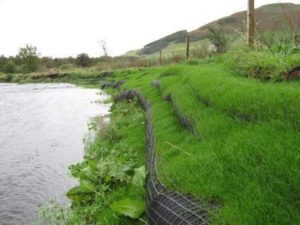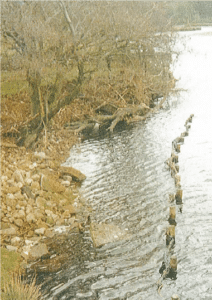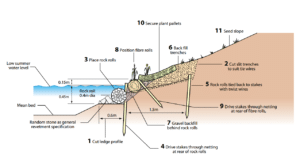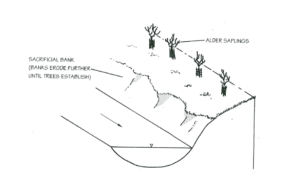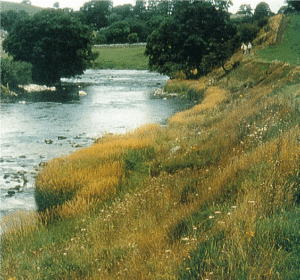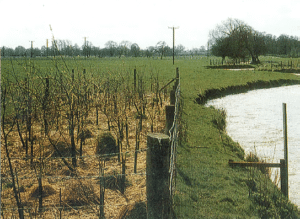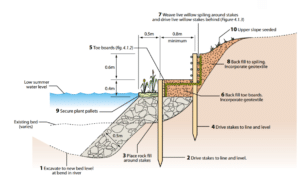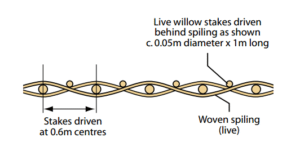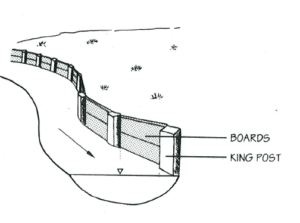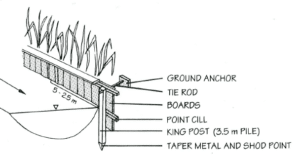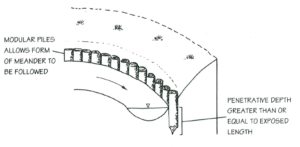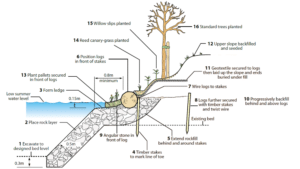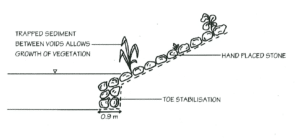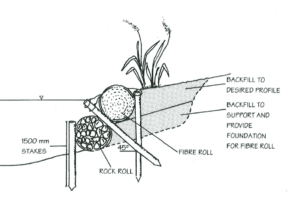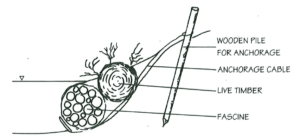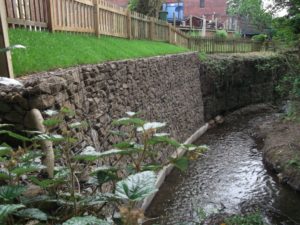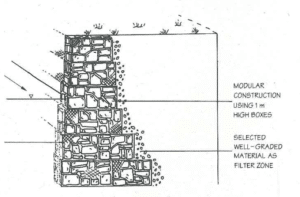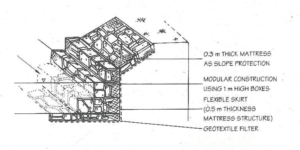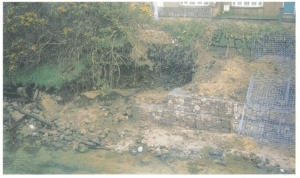Summary requirements
The following works require ordinary watercourse consent from the Lead Local Flood Authority (Devon County Council) under Section 23 of the Land Drainage Act 1991:
- a) erect any mill dam, weir or other like obstruction to the flow of any ordinary watercourse or raise or otherwise alter any such obstruction; or
- b) erect a culvert in an ordinary watercourse, or
- c) alter a culvert in a manner that would be likely to affect the flow of an ordinary watercourse
Riparian owners typically have a right to maintain and protect the bed and banks of any watercourse that runs through or abuts their property from erosion.
If the works retain the original bank line and do not become an obstruction to flows then land drainage consent is not required for the permanent works, however the temporary works may need temporary works consent. Poorly constructed bank protection works on ordinary watercourses arguably are an obstruction to flow and Devon County Council would need to consider whether to consent such works.
In accordance to sections 61A and 61B of the Land Drainage Act 1994, Devon County Council recommends that wherever possible, natural methods of bank protection are used and hard man-made revetments are kept to a minimum.
When considering bank protection methods the following should be taken into consideration:
- Environmental impact/appearance of bank protection method
- Suitability for location
- Durability and flexibility
- Effect on channel capacity
- Effect on adjacent bank and structures
- Construction and maintenance implications including costs
Design summary
- The repair and protection work to the bank shall not encroach into the channel of the watercourse beyond the previous line of the bank.
- The works shall not raise the height of the top of the bank above either its height prior to the activity being carried out, or the height of the adjacent banks.
- Bank protection or revetment works should have an adequate toe, which should be taken down a minimum of 300mm below firm bed level.
- It is important to key the upstream and downstream ends of the protection works into the bank by at least 600mm at 45o to prevent erosion around the bank.
- Different methods of bank protection can withstand a variety of levels of attack, as listed in this document; decisions on the suitability of these methods needs to take into consideration the local context in which they will be set.
- During construction the owner/contractor shall use appropriate measures:
- to minimise sediment mobilisation;
- to minimise impact on biodiversity;
- to ensure there is no increase to flood risk or detrimental impact on drainage;
- for the storage and disposal of waste produced; and
- to prevent and minimise environmental harm.
Technical guidance references
- Biodiversity by Design Ltd, Salix River and Wetlands Services Ltd, Beckett Rankine Ltd and EcoSchemes Ltd., (2008). Estuary Edges: Ecological Design Guidance. Environment Agency.
- Environment Agency (1999) Waterway Bank Protection: A guide to erosion assessment and management. Environment Agency, Bristol, 235pp.
- Environment Agency (2010) Managing bank instability and erosion.
- River Restoration Centre (2002) Manual of River Restoration Techniques
- National Cooperative Highway Research Program (2005) Environmental sensitive channel and bank protection measures. NCHRP Report 544, Transportation Research Board, Washington DC, 59pp.
- SEPA (2008) Bank Protection: Rivers and Lochs. Engineering in the Water Environment Good Practice Guide. Document reference WAT-SG-23. Scottish Environment Protection Agency, Stirling, 48pp.
- SEPA (2002) Managing River Habitats for Fisheries: A Guide to Best Practice. Scottish Environment Protection Agency, Stirling, 36pp.
- SEPA (undated) Best Management Practices no. 87: Stream bank stabilisation.
- Thorne, C., Amarasinghe, I., Gardiner, J., Perala-Gardiner, C. and Sellin, R. (1998) Riverbank protection using willows. R&D Technical Report W154, Environment Agency, Bristol, 54pp
Non-engineering solutions
Allowed natural adjustment
Natural adjustment allows the bank to retreat, continuing until such a time as the channel adjusts and bank re-stabilises. It is based on the principle that all channels will adjust naturally over time to a state of dynamic equilibrium without the need for interference. This is appropriate where erosion and bank collapse can be left to continue, and the consequences are acceptable.
This low-cost option recognises that rivers adjust to a stable condition over time and erosion can create important habitats both in the river and on the banks. Using this approach will depend on the size and shape of the channel being satisfactory, and the new state of stability being reached within an acceptable period of time. There may be opposition from owners who stand to lose land to further erosion when the final width of the channel is difficult to predict.
It should also be noted that with wider channels, more sedimentation may occur which could cause an issue when navigation is required.
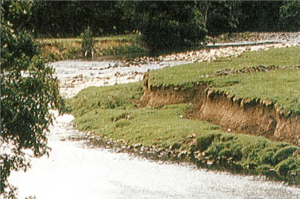
Figure 1. (Left) Development of vegetation on a bank which is stabilising through allowed natural adjustment. (Right) Erosion of a bank undermining protection measures, since the value of the assets threatened by the erosion is relatively low, allowed natural adjustment may be the more cost effective solution. (Source: EA, 1999, p.68-69)
Allowed natural adjustment is not suitable when:
- The consequences of allowing further erosion are severe
- Channel is not wide enough to accommodate future erosion
- The channel is not able to stabilise within the required amount of time.
- The integrity of flood defence is threatened
- The integrity of the channel is at risk
- There is damage to flow controlling structures
- Any pipelines, roads or railways are at risk of being damaged
- Boat wash is the main cause of erosion
- The bank is built up and close to property
- The major cause of erosion is human or animal activity
Management
Management of the river bank involves controlling human and animal activity to minimise their impacts. This should always be the preferred strategy when allowed natural adjustment is not suitable. Ongoing maintenance will be required to assess the effectiveness of any interventions. Alternatively, human and animal activity could be relocated if possible, such as moving a footpath.
This method is not suitable when the erosion is naturally occurring or when the bank failure is due to rotational slips.
Management of activity on the river bank is generally low cost and addresses the cause of the problem directly. It recognises erosion as a natural process which can be accelerated by animals or human impact and the tendency of river channels to adjust over time to changes in conditions. It also recognises that erosion can create important ecological habitats in channel and on river banks.
However, it could meet resistance from the users of the channel or land owners. Education of land owners and watercourse users can help with this.
Possible management solutions include:
- Appropriate fencing
- Tree management
- Regulation of boat traffic
- Mooring restrictions
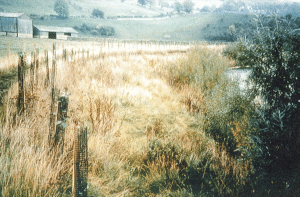
Fencing guidelines:
Fencing can limit surcharge, and the destructive impacts of humans and animals, allowing vegetation to establish and help to stabilise the river bank.
- It is important to allow erosion to continue for some time after fencing is installed to allow for natural stabilisation of the bank. Fencing should be placed a suitable distance from the bank to allow for this.
- Do not use solid fences which could obstruct any flow and cause debris to build up. The type of fencing used should be based on the following, depending on the flood risk and likely size of debris:
| Flood Risk | Sheep | Cattle |
|---|---|---|
| High | Low tensile single strand electric* | Low tensile single strand electric* |
| Medium | Single strand electric* | Two strand tension wire. Bottom strand plain* |
| Low | Multi-strand high tensile plain wire | 2 or 3 tensioned wire plain or barbed |
| Minimal | Stock fencing | 2 or 3 tensioned wire plain or barbed |
*In high and medium flood risk locations, the bottom strand of wire should be at least 600mm above the ground.
Table taken from Westcountry Rivers Trust fencing guidelines.
- For fencing alongside a Main River, you must contact the Environment Agency for advice
- For fencing alongside an ordinary watercourse please contact Devon County Council Flood and Coastal Risk Management Team.
Natural bank protection
Trees and shrubs
Re-vegetation is a frequently applied bank stabilisation technique, in which vegetation cover is increased through the establishment of young plants and trees or by planting seeds (SEPA, 2002). Vegetation can be established directly on or behind the exposed bank face or used in conjunction with pre-seeded or pre-planted geotextiles.
When reseeding, it is recommended that standard seed mixes are avoided in favour of a more diverse plant assemblage, which should be representative of locally occurring species (Environment Agency, 1999). Reseeded areas may need to be protected from the damaging effects of trampling, grazing by waterfowl, and consumption by seed-eating birds until young plants become established. A limited range of trees and shrubs are water tolerant and can be used for bank protection in the aquatic and damp zones. In the UK, the Willow (Salix) and Poplar (Populus) are the principle water tolerant species. Ash, Downy Birch, Buckthorn and Blackthorn may be used in slightly drier conditions. With this type of bank protection a dense root structure is required to provide some protection, as well as a substantial reinforcement to enhance the stability of the bank, above and below the water level. It is recommended that only native varieties should be planted with clear stem standards to minimise obstructions to flow. Planting should be configurated as to avoid obstruction to maintenance of the channel.
Although this technique is able to withstand relatively high flow velocities (1.8 m/s for long periods and 4.5 m/s for short periods), it generally cannot withstand the effects of wave action and is unsuitable for very steep or vertical banks (Environment Agency, 1999).
Figure 3. A flexible revetment, using rock rolls as toe protection and plant rolls to resist undercutting (Source: River Restoration Manual, 4.4)
As an alternative to reseeding, young trees and shrubs can be established on top of the bank (Environment Agency, 1999). These can be supplied as plug plants or saplings. Plants are often planted directly into bare soil or through jute matting which provide temporary erosion protection of the soil. As these plants develop, their root systems help to stabilise the bank and reduce further erosion. Riparian trees such as alder and voracious shrubbery such as bramble are particularly well suited as saplings, although a more diverse species assemblage that is representative of local species is recommended (Environment Agency, 1999).
Trees should be established in small groups, at a distance of between 0.5 and 1m from the channel edge. If trees are planted closer to the bank, the root systems may lead to further damage. Conversely, if they are planted further away, their root densities may be insufficient to have a beneficial effect (Environment Agency, 1999). Re-vegetation has been demonstrated to effectively stabilise a river bank. Plant roots bind soil particles and limit geotechnical failure and the presence of trees and ground-cover vegetation acts as a physical barrier against soil erosion (Thorne et al., 1998). This technique can provide a long-term solution to bank instability but is not suitable for application in the short term.
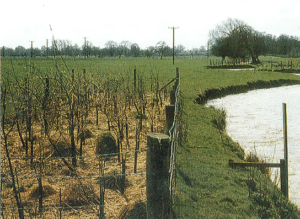
Figure 4. Schematic diagram of a bank stabilised using young trees (Source: EA, 1999, p.145)
Use of grass
Grass is very extensively used in bank protection in the zones above normal water level; however, it cannot tolerate prolonged submergence. Particular care is needed to ensure that adequate protection is maintained throughout the transition to the wet zones of the bank. A wide variety of grass species are available, from which appropriate mixtures can be selected to satisfy the functional, environmental and management requirements for the protection scheme. (Environment Agency, 1999)
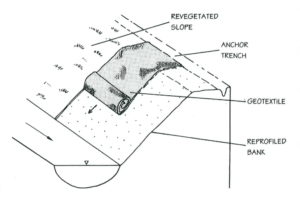
Figure 5. Grass revetment with wildflower mix and schematic of geotextile installation to encourage growth. (Source, Environment Agency, 1999, p.127 & 151)
Tree roots
Root wads are composed of cut tree trunks, complete with the root system (Figure 6). The trunks are pushed into the river bank, and the roots remain exposed (NCHRP, 2005; SEPA, 2008). This reduces the energy of the water flow and deflects water away from the banks which reduces bank erosion. The general rule of thumb is two thirds of the trunk should be keyed into the bank with the remaining third which includes the root wad projecting out into the river. However, this technique can also create scour by locally increasing turbulence and its placement should be carefully considered (SEPA, 2008).
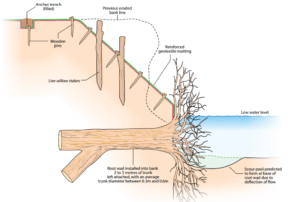
Figure 6. Bank protection using root wads to protect the toe of the bank from erosion, plan showing position of root wads. (River Restoration Manual, 4.8)
Coir rolls and pallets
Coir roll is made of coir fibre (from coconut husks) hydraulically pressed into a polypropylene or coir net bag and tied. Coir rolls are available as either an unplanted, pre-planted or mature planted product and are typically used to protect the toe of the bank from erosion. They are also used to provide instant marginal vegetation in river restoration schemes. The concept behind coir rolls is the plant root system will establish into the bank or bed and persist once the coir degrades and hence become self-sustaining.
They provide an excellent method of introducing instant, marginal habitat and can be used in low to medium energy environments with velocities up to 3.5 m/s. They are best suited to river margin depths of up to 300mm and the river level at which they are placed should be considered carefully; too high and the plants will be left high and dry, too low and the plants will struggle to photosynthesise.
Coir rolls are not recommended to be used as terrace features on banks nor do they adapt very well to locations which are heavily shaded. Coir rolls have become a very popular soft engineering technique in recent times with different rates of success, however if installed correctly and used appropriately, they are an excellent option for sustainable bank toe protection.
Coir pallets are made of a thin coir mattress which supports a variety of marginal plant species. The mattress is cut into pallets (typically 2 x 1m or 2 x 1.5m) and can be placed directly on the channel margin or over other treatments such as brushwood providing instant marginal habitat. (Environment Agency, 2010)
Willow spiling
Willow spiling is a traditional soft engineering technique used to stabilise eroding banks. It consists of weaving live willow rods between live willow stakes set into the affected bank at regular intervals. The space behind the willow wall to the existing bank is then filled with soil to provide an area for the willow roots to grow.
Osier willow is considered to be the most appropriate species to provide poles, due to its pliable nature and the fact that it is an indigenous species (RRC, 2002). Alternatively, commercially available alternatives could be used, but these will require more vertical support posts (RRC, 2002). Willow spiling is normally carried out between November and April during the harvesting of the willow (dependent upon the season) and should be installed within three weeks of harvest.
Spiling is generally considered to be effective in most fluvial environments, except for high-energy gravel bed channels which may be too mobile. The technique can be applied on steep and vertical banks but cannot be used as a retaining structure (Environment Agency, 1999). The RRC (2002) note that this technique does not have the flexibility to accommodate natural bank settlement, and the use of geotextiles or mattressing may be preferable if there is not a plentiful local supply of osier willow. However, this technique can be used in relatively narrow spaces, which may be an advantage in some situations.
It should be noted that willow spiling does require regular maintenance and is not suitable for small river channels where vegetation growth could potentially obstruct flow.
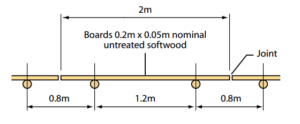
Figure 8. Profile of spiling revetment Willow where spiling has been successful used in conjunction with rock reinforcement below the waterline, wooden toe boarding at the low water level, and synthetic geotextiles. Also see plan view of spiling and plan view of toe boards (Source: River Restoration Manual, 4.1).
Structural bank protection
Timberwork
As outlined by Environment Agency (1999), Toe boarding is normally used to support the toe of a bank and to protect it from erosion. Timber boards are placed with their upper edge above the average winter flow level or boat wash. In rural areas, the use of split larch poles instead of boards and toe posts is common. Combinations of trees and toe boarding produce good environmental results, with the boarding to the bank protecting the newly planted trees. As the trees become established they take over the role of bank stabilisation from the rotted out boards.
Figure 9. Toe boarding/timber toe revetment (Source, Environment Agency, 1999, p.177)
Timber piling can also be used, which should be driven in and anchored. The area is then backfilled with imported or dredged material and compacted. The length of pile exposed should be no greater than the penetrated length (shorter piles may be acceptable for consolidated silts and clays). The length of rods should vary to reduce the possibility of ground cleavage. (Environment Agency, 1999)
Figure 10. Timber piling (Source, Environment Agency, 1999, p.177).
Brushwood toe, is where logs and brush or trunks can be laid along the bank and firmly wired into place using heavy gauge wire attached to stakes, driven in to the bank. The brushwood will trap sediment and then support vegetation growth. (Environment Agency, 1999)
Figure 11. Brushwood toe (Source, Environment Agency, 1999, p.177).
Tree trunks or large boughs can be used along the toe of the bank to help stabilise. Geotextile is then used on the bank above to encourage vegetation, such as willow plants to establish and aid stabilisation. Figure 12 illustrates this technique where logs have been anchored into the bank to ensure they do not float. The use of willow planting above will eventually provide the stabilisation needed so the log does not need to be durable. Backfill has then been extended approximately two thirds of the bank height and reprofiled, with geotextile secured on top and covered in soil. (River Restoration Manual 4.3)
Figure 12. Profile for log toe revetment. Source: River Restoration Manual 4.3
Stonework
Stone revetments can control erosion by increasing the roughness of the bank and reducing the velocity of flows. Figure 13 shows a single layer of uniformly sized stone where sediment can build up in the voids and aid vegetation growth. Random placing of stone may be preferred to give a more natural appearance.
Figure 13. Hand-pitched stone (Source: Environment Agency, 1999, p.185)
This method is flexible to accommodate changes in channel geometry and can provide immediate protection to the bank. However, it is not suitable for steep banks, so may require regrading or alternative methods sought. The stone weight should be of sufficient size to avoid being moved by the force of the watercourse. It is important here to key in the upstream and downstream ends of the stone to avoid outflanking.
Rock rolls
Rock rolls are flexible ‘sausages’ of crushed rock contained with nylon netting that are placed at the bank toe to prevent undercutting and fluvial scour. Rock rolls are typically 300 to 400mm in diameter and come in 2 m or up to 5 m lengths.
They are installed at a depth of 0.1 to 0.5 m (although can be stacked) and are effective in velocities up to 4 m/s (low to moderate flow). They are effective in rivers with wave action up to 0.4 m high.
This method provides immediate protection from erosion and after the establishment of vegetation should provide long term protection.
Figure 14 shows the toe of the bank being protected by a rock roll and supported stakes. A second, fibre roll is installed at water level to protect against wave energy whilst the vegetation establishes.
Figure 14. Rock and fibre roll (Source: Environment Agency, 1999, p.163)
Figure 15 shows a roll method using timber material, made form timber or fascines and covered with geotextile. A lower roll is placed at the toe of the bank and a second at the mean summer water level. Timber piles or stakes then provide lateral support and the structure is backfilled with soil.
Figure 15. Timber and vegetation bulkheads/rock brush fascine (Source: Environment Agency, 1999, p.164)
Bagwork
Bagwork bank protection uses concrete filled hessian bags which can be arranged in a brickwork pattern. Nylon and other man-made materials are not acceptable.
Bags are generally laid with a dry mix inside, to allow moving and shaping, and which then hardens in situ. A dent can be made on the top surface of the bagwork to encourage deposition of silt and vegetation. Bagwork should be laid on a slope wherever possible, even slightly, to increase stability. Steel “road pins” can be driven through the bags to reinforce it further. It is important to ensure that bagwork foundations are secure and will not be undercut.
Extensive bagwork can create a visually obtrusive form of bank protection. Over time however, the concrete will age and look more like stone, becoming slightly less visually intrusive.
Gabions
Gabions, or gabion baskets are wire cages filled with stone and are often used as retaining structures for steep banks. Their use in watercourses however must be appropriate to avoid failure due to their inherent nature of settling and consolidating over time with the constant flow of water.
Gabion baskets can be stacked to act as a retaining wall, where units are wired together to ensure structural integrity. The front face of the wall should be constructed with an angle of 10:1, achieved either by sloping the foundations or stepping the baskets back slightly each layer.
The wall should be based on a solid foundation, which should be deeper in high energy/fast flowing watercourses. Ideally, the top of the foundation (e.g. concrete base) and the base of the gabion wall should sit above the normal water level to avoid erosion and movement of the stones, which could result in failure.
The baskets should preferably be hand filled with stone to allow for tighter packing and reduced voids. In time the stones with more space to move can settle, increasing the risk of structural failure.
The upstream and downstream ends of the wall will need to tie in with the existing river bank to avoid outflanking.
Gabion baskets are not suitable for use in rivers often in spate that carry large bed load and coarse gravels.
An alternative to building a wall with gabion baskets is a brick or blockwork retaining wall, which may also be suitable in locations with very steep banks and there is no option or space for grading the banks back to a stable angle.
Figure 16. An example of a well installed gabion wall on a concrete base, alongside another gabion wall being undermined at the base and starting to fail. (Source: DCC)
Figure 17. Gabion wall constructed with appropriate front face angle. (Source: Environment Agency, 1999 p.189)
The gabion mattress is a thinner and more flexible structure that the basket design, typically 6m x 2m, with 150-300 thickness. It can be used to protect the slope of the bank or used as an apron at the toe of the bank. They should not be used on slopes greater than 1:1.5. See figure 18.
Figure 18. Use of a gabion mattress on a slope. (Source: Environment Agency, 1999 p.189)
Gabions can be used in combination with vegetation. For example, they can be covered in soil and geotextile to reduce visual impact, as seen in Figure 19.
Figure 19. Installation of gabions on an eroding bank wall (Source: Environment Agency, 1999 p.190)
This is a supporting document to Devon’s Local Flood Risk Management Strategy and should be seen as a live document to be updated as new best practice, grants and schemes become available.
We welcome comments from land owners and farmers on best practice and any case studies you would like to share. Please contact Devon County Council Flood Risk Management at floodrisk@devon.gov.uk.
